The Øresund bridge from Malmö, Sweden, to Copenhagen, Denmark, is a beautiful, wide, seven-mile, four-lane bridge with such wide shoulders we hardly knew we were on a bridge. And then after about 10 km you descend into a tunnel three miles long before arriving in Denmark. Charge for the thrill: $118, if your RV is longer than six meters. Rover is.
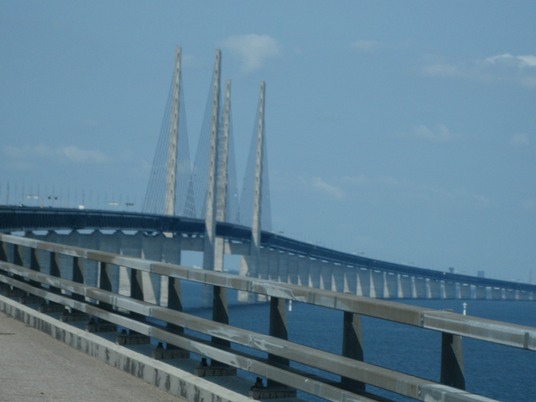
On our way to our first Danish campground we stopped at a grocery store. Since we had only Swedish kroner in our pockets, we cautiously asked whether they took Swedish money before we put anything in our cart. ‘Yes,’ said the young man at the counter, so we proceeded to fill our basket, but just as we arrived at the checkout counter, he left. Confusion...low-level Scandinavian impatience. It took a manager, lots of key punching, and even more time--holding up everyone behind us--before we got out of the store. A helpful woman (who earlier had helped us chose detergent and gum and got stuck behind us at the checkout) pointed us in the direction of a large shopping center, where we were able to find an ATM and stock up on Danish kroner.
When we arrived at the campground, we were happy to learn they had received the campground book Susan had ordered from England. They sent us to the beach side of the road, where there was a lovely park-like setting with no children under 13 . . . and also no wifi. So the next day, when we had returned from Copenhagen and noticed that the spot next to the reception office had been vacated, we moved Rover there because it was the only spot in the campground where you didn’t have to sit outside on a hard bench to get internet reception. (A word of warning: this campground’s blurb in the guidebooks had promised ‘WiFi.’)
It had also promised a short walk to the train station and then 15 minutes to the city center. The ‘short walk’ turned out to be nearly a mile; what’s more, because work was being done on the tracks, a bus took passengers on a 20-minute ride to the first functioning station. Then it was only 10 minutes into the city. (The worst part was that the bus went right past the campground, so on the return trip we asked the driver to stop and let us off. Reluctantly, he did.)
Copenhagen is a lovely city, but circumstances conspired to exhaust us. Every large street seemed to be undergoing repaving, rendering bus maps impossible to follow . . . even right in front of the central train station. Construction of several new metro disrupted whole intersections. Bicycles were everywhere, headed in every direction. We saw cyclists ranging from elderly people, chugging along, to young men in suits and young women with children in baskets on the front or back (or both),
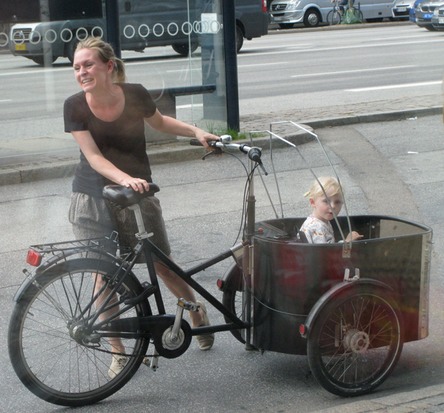
to frightened tourists who’d thought it would be a good idea to rent one . . . and almost none of them wearing a helmet. You quickly learned not to just step out from a sidewalk or onto a bus without looking up and down the bike lane.
When we did raise our eyes from traffic hazards, we noticed how beautiful Copenhagen is: canals crowded with houseboats and yachts; spires on once-important buildings everywhere you looked; miles of four- and five-story stone buildings, built before elevators were invented, with ornately carved facades; large open squares, each with its own statue and pigeons; and, of course, palaces. And through all of it swarmed tourists, buses, and bicycles.
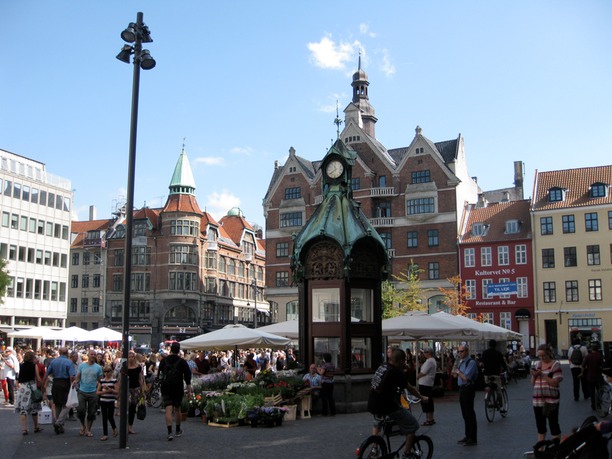
After the cool rainy weather in Norway and Sweden, Copenhagen was hot under the bright sun in the clear blue sky. We started our touring on Monday, when most of the museums were closed. According to Susan’s pedometer, we racked up 14,000 steps (about seven miles), walking the pedestrian shopping streets, visiting Danish design studios and churches, and taking a canal tour to rest. On Tuesday (18,000 steps) we visited no fewer than five museums, one of which featured a huge Degas exhibit that, because it took over the museum’s entire ‘French’ section, prevented Susan from adding one more Monet to those she has seen in person. Another one we visited--this one particularly difficult to find--was a theatre museum in one of the city’s many royal palaces, dating from 1767 and refurbished in the 1800s. Visitors could walk all around the auditorium, onto the stage, among the costume displays, and even into the king’s own box.
That evening we ate dinner in Tivoli, the full city block of amusement park, restaurants, and gardens right in the city center. Because we had stayed longer in the city that evening, we came back on a later train, only to find we’d missed the last bus to our station. Instead we had to take a different bus to a different station, then take another train two stops to our station, and then, of course, walk back to the campground.
We might have considered staying another day but the long trip into the city, combined with the heat and humidity, proved to be just a little too much for us. So on Wednesday we drove around Copenhagen on a ring road and headed north 34 miles to “Louisiana,” a modern art gallery on a beautiful spot with gorgeous trees and gardens overlooking the Kattegatt.
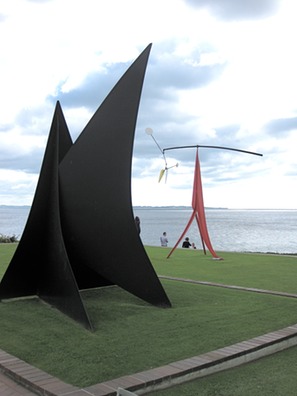
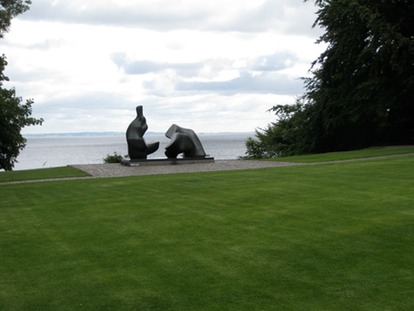
We stopped at a nearby family-run campground and just relaxed for the rest of the day. The weather has turned cool and very windy, and either Rover doesn’t like our electrical connection or the campground doesn’t like our power demands. Whichever is the case, we’re registering less than 110 volts and have tripped one of their circuit breakers.